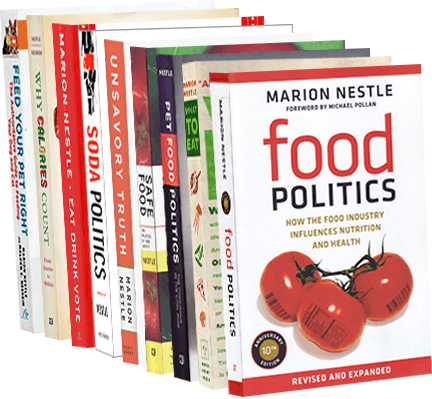Today’s food politics of Ebola
Ebola is much in the news, and for good reason. It is highly contagious, difficult to contain, and deadly.
In food studies, we say that food is a lens through which to view the most important problems of society. Here are some thoughts on the food politics of Ebola.
Dietary Supplements for Ebola Prevention or Treatment
The Council for Responsible Nutrition, the trade association for supplement manufacturers, has found it necessary to issue an advisory on use of dietary supplements to prevent or treat Ebola infections.
The American Herbal Products Association (AHPA), the Consumer Healthcare Products Association (CHPA), the Council for Responsible Nutrition (CRN), the Natural Products Association (NPA), and the United Natural Products Alliance (UNPA) are therefore endorsing the following unified advisory for marketers and retailers, as well as for consumers of dietary supplements:
- Marketers and retailers of dietary supplements are urged to refuse to stock or sell any supplements that are presented as treating or curing Ebola virus disease, or preventing Ebola virus infection.
- Marketers and retailers should refrain from promoting any dietary supplement as a cure or treatment for Ebola virus disease.
- Anyone who believes they may have Ebola virus disease or may have come in contact with the Ebola virus should contact a healthcare professional immediately. The Centers for Disease Control and Prevention has more information on Ebola virus disease and the proper actions to take if you suspect you are ill.
The knowledge that no known treatment exists for Ebola has not stopped supplement manufacturers from advertising the benefits of their products for this infection.
FDA Warning Letters
The FDA has stepped in and issued warning letters to three manufacturers marketing their products as possible treatments or cures. The FDA letters, which make interesting reading, went to:
Marketing of Nutritional Supplements
A simple Google search of “supplements Ebola” turned up this kind of information this morning:
The Ebola virus can be destroyed naturally – despite what you’ve been told To date, not a single virus has been tested that is not inactivated (killed) by a large enough dose of vitamin C (ascorbic acid). Many other antioxidants have similar virucidal effects, but vitamin C appears uniquely to be of greatest potency and clinical efficacy, as its simple chemical structure allows for it to be disseminated throughout the body with little restriction… Vitamin C is both very potent and optimally bioavailable in accessing any viral infection.
And this:
The substances in the Natural Allopathic protocol for Ebola offer a power unequalled in the world of medicine that we can harness to save many lives of people infected with Ebola…. Magnesium salts, sodium bicarbonate (baking soda), iodine, selenium and vitamin C are concentrated nutritional medicinals that have been used in the direst of medical circumstances…The core of the Natural Allopathic protocol redefines the way emergency room and intensive care should be practiced on Ebola patients with proven fast-acting, safe, concentrated and mostly injectable nutritional medicines. If the Ebola infection truly gets out of hand, it is comforting for parents to know that they can legally administer these same medicinals if infected people are treated at home. All of the Natural Allopathic Medicines can be also taken orally or used transdermally (topically) to almost the same effect if treatment is started early enough.
How Can Supplement Makers Do This?
The ability of supplement manufacturers to claim health benefits for their products, and mostly get away with it, is a result of congressional action in passing the Dietary Supplement Health and Education Act of 1994 (DSHEA), which essentially deregulated these products.
Twenty years later, the supplement industry is deeply divided between responsible and irresponsible manufacturers, both allowed by law.
As the president and CEO of one supplement company puts it,
The industry of 1994, roughly $8 billion in sales, has experienced compounded double-digit growth every year since DSHEA became law…DSHEA opened the door to growth, innovation, new science, new discovery and a nation of wanting consumers enchanted with the thought that there are natural solutions to their individual health needs…20 years later, it’s time to take a hard look at what DSHEA doesn’t provide to the industry today. The barrier to entry into this industry continues to have no hurdles; DSHEA does not define the boundaries of consumer trust… The generations of today, and the generations of tomorrow will demand transparency, they will demand efficacy, and they will demand quality and safety from all of us.
Clearly, they aren’t getting that now.
Other Connections to Food Politics
Chocolate
EBOLA THREATENS WORLD’S CHOCOLATE SUPPLY: Ivory Coast, the world’s largest producer of cacao, the raw ingredient in M&Ms, Butterfingers and Snickers Bars, has shut down its borders with Liberia and Guinea, putting a major crimp on the workforce needed to pick the beans that end up in chocolate bars and other treats just as the harvest season begins… the outbreak already could raise prices…Prices on cocoa futures jumped from their normal trading range of $2,000 to $2,700 per ton, to as high as $3,400 in September over concerns about the spread of Ebola to Côte D’Ivoire.
Food safety
Food safety lawyer Bill Marler points out that Ebola started out as a foodborne illness. Its most likely source was infected bushmeat that transferred the virus to human handlers.
Following standard food safety procedures is always a good idea while hoping that health officials get this epidemic under control.



